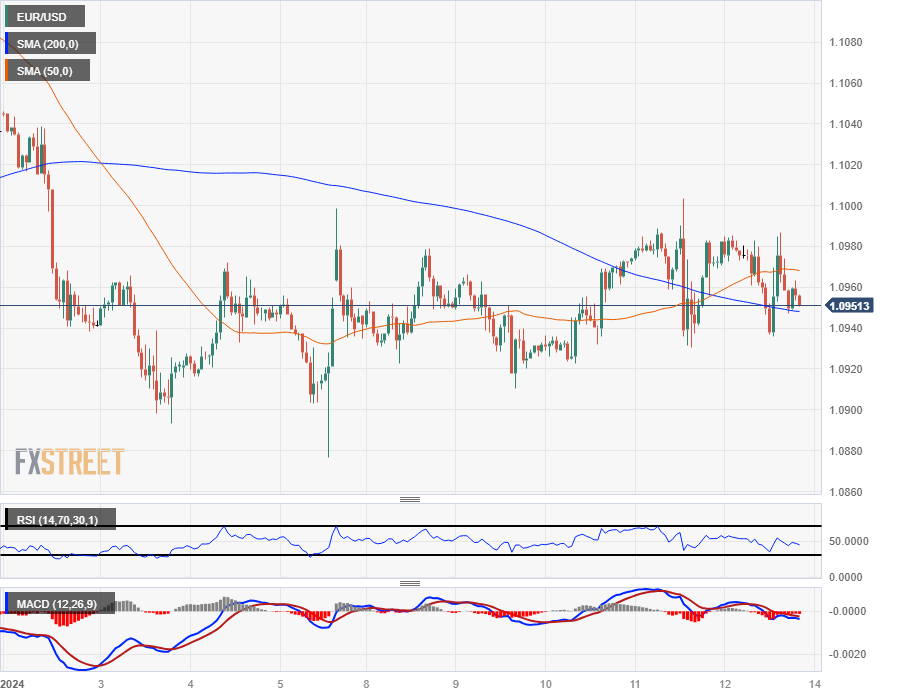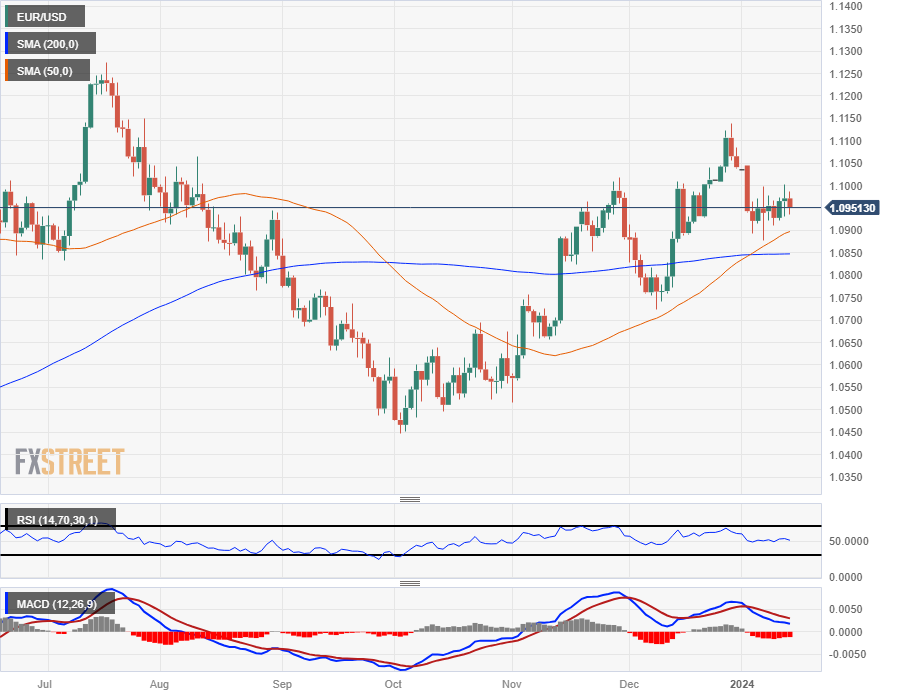- Euro struggles to gain momentum on Friday, pares back week’s performance.
- A slew of ECB talking points this week have bid down rate cut hopes.
- Next week’s economic calendar is light on eurozone data.
The Euro (EUR) is softening on Friday, backsliding against the majority of its major currency peers as dovish talking points from the European Central Bank (ECB) weigh on rate cut hopes. Next week sees limited eurozone data releases, with mid-tier Industrial Production and final Harmonized Index of Consumer Prices (HICP) due in the first half of the week.
A consensus miss on the US Producer Price Index (PPI) is the driving headlines on Friday as producer-level inflation recedes faster than expected. Slumping producer inflation kicked market expectations of Fed rate cuts into overdrive heading into the week’s final trading hours.
Daily digest market movers: Euro broadly weaker in Friday trading amidst dour outlook
- The Euro is down against most of the major currency bloc on Friday, declining 0.15% against the US Dollar (USD).
- ECB’s President Lagarde: Rates have probably reached peak, EU not in recession.
- Multiple ECB officials have hit the wires this week, easing back market hopes of rate cuts.
- The ECB’s Economic Bulletin begrudgingly admitted the eurozone was in a “technical recession” with a soft landing scenario all but guaranteed.
- US annual PPI inflation rises to 1% in December vs. 1.3% expected.
- MoM US PPI in December held at -0.1%, in-line with November’s -0.1% (revised downward from 0.0%), missing the market forecast of 0.1% growth.
- Annualized core PPI also missed the mark, declining to 1.8% from November’s YoY figure of 2.0% and coming in below the median market forecast of 1.9%.
- Easing PPI inflation sparked a pop in Federal Reserve (Fed) rate cut expectations.
- Markets once again see 160 basis points in Fed rate cuts through 2024, up from 154 bps.
Euro price this week
The table below shows the percentage change of Euro (EUR) against listed major currencies this week. Euro was the strongest against the Australian Dollar.
| USD | EUR | GBP | CAD | AUD | JPY | NZD | CHF | |
| USD | -0.09% | -0.23% | 0.35% | 0.49% | 0.11% | 0.10% | 0.20% | |
| EUR | 0.08% | -0.15% | 0.44% | 0.57% | 0.19% | 0.19% | 0.25% | |
| GBP | 0.23% | 0.14% | 0.60% | 0.72% | 0.35% | 0.34% | 0.43% | |
| CAD | -0.35% | -0.43% | -0.57% | 0.14% | -0.23% | -0.25% | -0.18% | |
| AUD | -0.49% | -0.57% | -0.72% | -0.14% | -0.37% | -0.39% | -0.31% | |
| JPY | -0.12% | -0.18% | -0.34% | 0.27% | 0.40% | 0.01% | 0.09% | |
| NZD | -0.09% | -0.20% | -0.33% | 0.26% | 0.39% | 0.01% | 0.10% | |
| CHF | -0.19% | -0.25% | -0.40% | 0.19% | 0.33% | -0.06% | -0.06% |
The heat map shows percentage changes of major currencies against each other. The base currency is picked from the left column, while the quote currency is picked from the top row. For example, if you pick the Euro from the left column and move along the horizontal line to the Japanese Yen, the percentage change displayed in the box will represent EUR (base)/JPY (quote).
Technical Analysis: EUR/USD lower on Friday in chunky trading
The EUR/USD kicked off Friday’s trading near 1.0980, going back and forth in a rough intraday range as the pair grapples with bids near 1.0950. Intraday action continues to get hamstrung on the 200-hour Simple Moving Average (SMA). Near-term chart action is getting drawn into the midrange as the Fiber churns in rough consolidation.
According to daily candles, the pair is doing well, up nearly 5% from October’s bottom bids near 1.0450. Despite a pullback toward the 200-day SMA, a bullish cross of the 50-day and 200-day SMAs is building out a near-term price floor around 1.0900.
Continued selling pressure will drive the Fiber back into the long-term 200-day SMA near 1.0850. The challenge will be to drag the EUR/USD down to the last swing low near 1.0750. Bidders will be looking for topside momentum to carry the pair back into late December’s swing high near 1.1150.
EUR/USD Hourly Chart
EUR/USD Daily Chart
Euro FAQs
The Euro is the currency for the 20 European Union countries that belong to the Eurozone. It is the second most heavily traded currency in the world behind the US Dollar. In 2022, it accounted for 31% of all foreign exchange transactions, with an average daily turnover of over $2.2 trillion a day.
EUR/USD is the most heavily traded currency pair in the world, accounting for an estimated 30% off all transactions, followed by EUR/JPY (4%), EUR/GBP (3%) and EUR/AUD (2%).
The European Central Bank (ECB) in Frankfurt, Germany, is the reserve bank for the Eurozone. The ECB sets interest rates and manages monetary policy.
The ECB’s primary mandate is to maintain price stability, which means either controlling inflation or stimulating growth. Its primary tool is the raising or lowering of interest rates. Relatively high interest rates – or the expectation of higher rates – will usually benefit the Euro and vice versa.
The ECB Governing Council makes monetary policy decisions at meetings held eight times a year. Decisions are made by heads of the Eurozone national banks and six permanent members, including the President of the ECB, Christine Lagarde.
Eurozone inflation data, measured by the Harmonized Index of Consumer Prices (HICP), is an important econometric for the Euro. If inflation rises more than expected, especially if above the ECB’s 2% target, it obliges the ECB to raise interest rates to bring it back under control.
Relatively high interest rates compared to its counterparts will usually benefit the Euro, as it makes the region more attractive as a place for global investors to park their money.
Data releases gauge the health of the economy and can impact on the Euro. Indicators such as GDP, Manufacturing and Services PMIs, employment, and consumer sentiment surveys can all influence the direction of the single currency.
A strong economy is good for the Euro. Not only does it attract more foreign investment but it may encourage the ECB to put up interest rates, which will directly strengthen the Euro. Otherwise, if economic data is weak, the Euro is likely to fall.
Economic data for the four largest economies in the euro area (Germany, France, Italy and Spain) are especially significant, as they account for 75% of the Eurozone’s economy.
Another significant data release for the Euro is the Trade Balance. This indicator measures the difference between what a country earns from its exports and what it spends on imports over a given period.
If a country produces highly sought after exports then its currency will gain in value purely from the extra demand created from foreign buyers seeking to purchase these goods. Therefore, a positive net Trade Balance strengthens a currency and vice versa for a negative balance.



